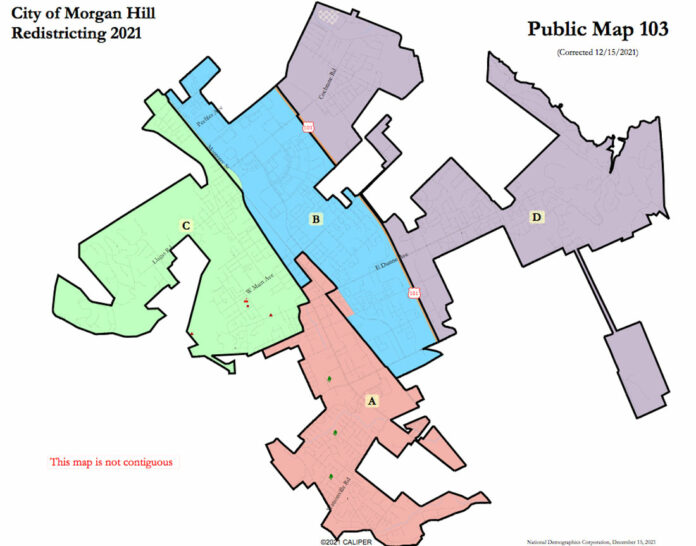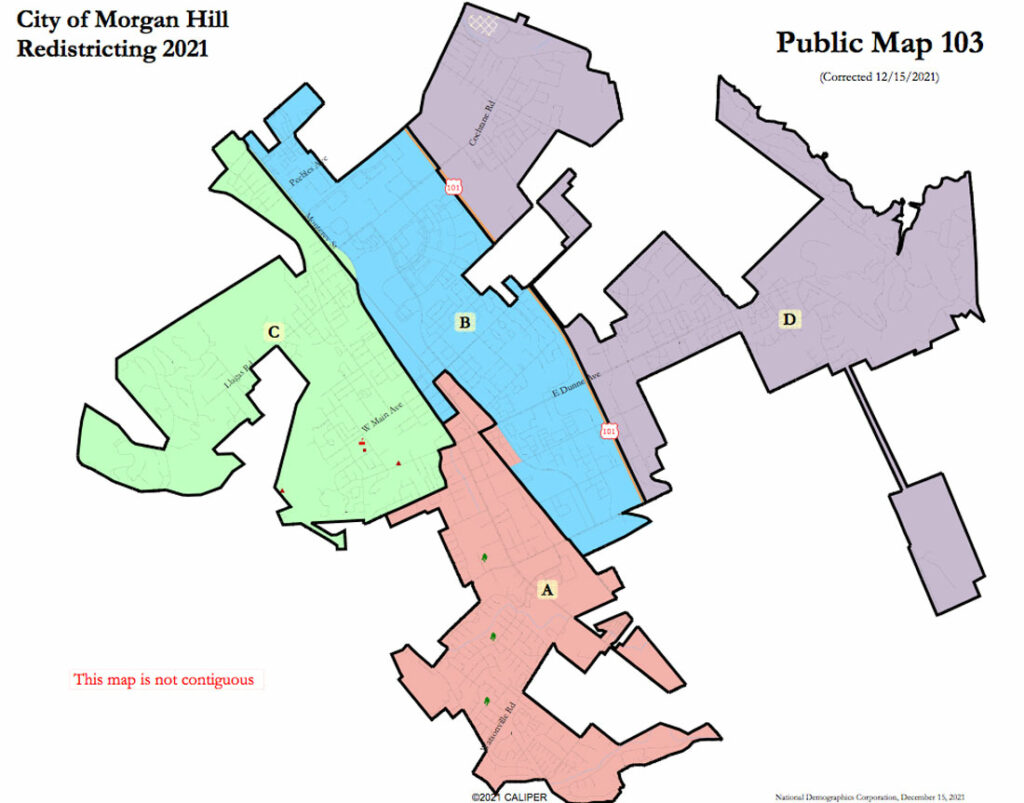
Following a months-long discussion that grew increasingly contentious, the Morgan Hill City Council last week narrowly voted to approve a new elective district map that could expose the city to a lawsuit.
But late in the March 2 council discussion, it became clear that the city might face legal action regardless of what they decided, as local attorney Armando Benavides in public comments threatened to sue the city if the council approved any redistricting boundaries other than those presented in “Map 103,” which largely leaves the four existing council districts intact.
The council voted 3-2 to approve Map 103, which was one of six maps under consideration.
Benavides’ threat was enough to influence Mayor Rich Constantine, who voted in favor of Map 103.
“I’m going to err on the side of knowing we’re going to get sued versus the possibility of getting sued,” Constantine said. “When I look at the possibility of being sued, (it would happen) if we keep the map the way it is; whereas, if we change (existing boundaries) we’re guaranteed to be sued.”
Councilmembers John McKay and Gino Borgioli voted against the motion to approve Map 103.
At the center of the debate over the legality of the maps is a requirement under a new state redistricting law—the California Fair Maps Act—that elective districts must be geographically contiguous. Map 103 was the only proposal where there was a question about such contiguity.
District D, which covers the east side of Morgan Hill in Map 103, consists of two regions that are separated by a patch of unincorporated county land. Morgan Hill City Attorney Don Larkin has argued that this means the district is not contiguous, and thus Map 103 is illegal and may invite legal action by anyone from a voting rights organization to an attorney “who will sue just to get attorney’s fees,” he said at the March 2 meeting.
“Any voter can sue to challenge under the Fair Maps Act and the (federal) Voting Rights Act,” Larkin said.
Larkin said he is not aware of any specific threats yet made against the city if it approved Map 103, but he didn’t waver from his advice.
“You don’t have to listen to me, but ethically I have to give you impartial advice,” Larkin told the council. “I am not trying to advocate for a position. If the council chooses not to follow (my advice) I’m not going to be offended. At this point I am not going to change my opinion” on Map 103 being non-contiguous under the law.
It was unclear from Benavides’ public comments at the March 2 meeting why he would sue the city or how the city might be in violation of the law if the council rejected Map 103. He later clarified that his threat was related to Larkin’s interpretation of the wording of the Fair Maps Act, which says districts must be contiguous “to the extent practicable.”
Benavides argued such a phrase is not strictly binding and gives the council enough discretion to declare districts contiguous. Plus, he thinks the overriding intent of the FMA legislation is to ensure the voting rights of minorities and other protected classes are preserved, regardless of other criteria listed in the law.
Larkin earlier in the meeting said, “(When) it comes to the contiguity, we have to make our districts contiguous if they can be made physically contiguous.”
Benavides later clarified that his lawsuit threat is off the table now that the council approved Map 103.

Other draft district maps considered by the council March 2 contained boundaries that are more clearly contiguous. The drafts were created over the preceding months—some by members of the public and some by the city’s redistricting consultant, National Demographics Corporation.
The Morgan Hill City Council wasn’t broken into districts until 2017, when attorneys threatened a Voting Rights Act lawsuit in order to ensure the city’s minority population was adequately represented on the five-person dais. The subsequent balloting in 2018 led to the election of Yvonne Martinez Beltran, a Latina council member who represents the current District B.
Cities with elective council districts—as well as other government bodies—are required by state and federal law to review their boundaries every 10 years based on changes in population and demographics presented in the U.S. Census.
The city officials’ ongoing discussion of its redistricting efforts has become increasingly contentious and divisive at the council dais in recent months. Constantine said March 2 that the debate had become “personal and emotional.” McKay and Martinez Beltran, who are both up for reelection in November and have been on opposite sides of the discussion, both said the redistricting efforts had turned “political.”
Martinez Beltran has staunchly advocated for Map 103 at recent public meetings. The map keeps her District B in its current boundaries, which include downtown Morgan Hill and areas between Monterey Road and Highway 101.
During council discussion March 2 and at a previous redistricting workshop, Martinez Beltran referred to emails from Benavides to bolster her case for Map 103. The map, she said, preserves “communities of interest” in her district along the Monterey Road corridor—specifically, a higher concentration of home renters, lower-income residents and downtown neighborhoods.
Under the FMA, the preservation of communities of interest is another criteria that cities should consider in drawing their district boundaries, according to city staff. In addition to geographical contiguity, other criteria include easily identifiable boundaries and districts must be “compact.”
The highest priority criteria in drawing districts are broadly considered to be equal population; compliance with the federal Voting Rights Act; and “no racial gerrymandering,” Dr. Justin Levitt of NDC told the council.
Martinez Beltran said March 2, “We have a duty to ensure that the communities of interest in Morgan Hill are represented, and yes, some of those are renters, some are low-income, some are minorities and underrepresented.”
McKay made a motion at the March 2 meeting to approve a different draft known as the “Green” map, which was created by NDC. That map was produced with the “least possible changes” to the existing boundaries in mind, while breaking up Districts D and B so all four districts were contiguous.
But that motion failed on a 2-3 vote, with Constantine, Martinez Beltran and Council member Rene Spring opposed.
McKay and Borgioli expressed their concerns with the potential illegality of Map 103, and the risk of a lawsuit it might bring to the city.
“I’m concerned that we moved a map forward that does not meet the most prominent requirement we were given: contiguity,” McKay said after the meeting. “And I’m worried we got to the place we did through what sounded like politics.”







